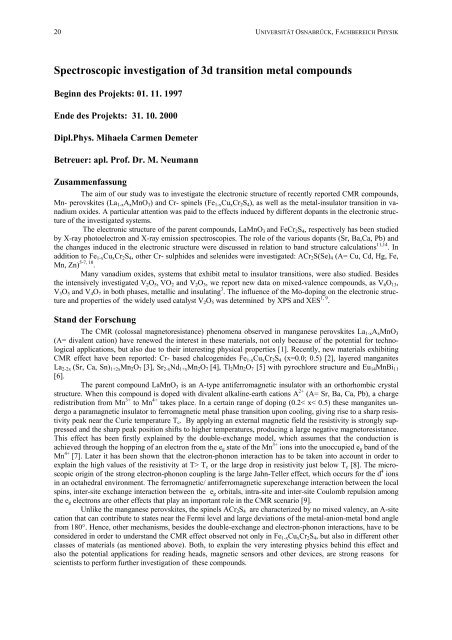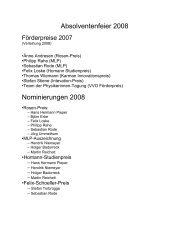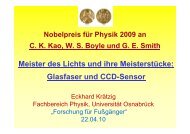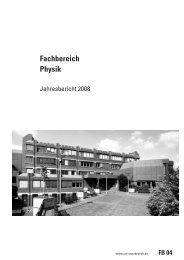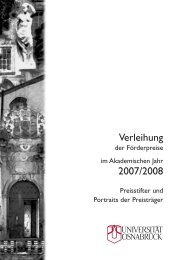Universität Osnabrück, Graduiertenkolleg Mikrostruktur oxidischer
Universität Osnabrück, Graduiertenkolleg Mikrostruktur oxidischer
Universität Osnabrück, Graduiertenkolleg Mikrostruktur oxidischer
Sie wollen auch ein ePaper? Erhöhen Sie die Reichweite Ihrer Titel.
YUMPU macht aus Druck-PDFs automatisch weboptimierte ePaper, die Google liebt.
20 UNIVERSITÄT OSNABRÜCK, FACHBEREICH PHYSIK<br />
Spectroscopic investigation of 3d transition metal compounds<br />
Beginn des Projekts: 01. 11. 1997<br />
Ende des Projekts: 31. 10. 2000<br />
Dipl.Phys. Mihaela Carmen Demeter<br />
Betreuer: apl. Prof. Dr. M. Neumann<br />
Zusammenfassung<br />
The aim of our study was to investigate the electronic structure of recently reported CMR compounds,<br />
Mn- perovskites (La1-xAxMnO3) and Cr- spinels (Fe1-xCuxCr2S4), as well as the metal-insulator transition in vanadium<br />
oxides. A particular attention was paid to the effects induced by different dopants in the electronic structure<br />
of the investigated systems.<br />
The electronic structure of the parent compounds, LaMnO3 and FeCr2S4, respectively has been studied<br />
by X-ray photoelectron and X-ray emission spectroscopies. The role of the various dopants (Sr, Ba,Ca, Pb) and<br />
the changes induced in the electronic structure were discussed in relation to band structure calculations 11,14 . In<br />
addition to Fe1-xCuxCr2S4, other Cr- sulphides and selenides were investigated: ACr2S(Se)4 (A= Cu, Cd, Hg, Fe,<br />
Mn, Zn) 5-7, 10 .<br />
Many vanadium oxides, systems that exhibit metal to insulator transitions, were also studied. Besides<br />
the intensively investigated V2O5, VO2 and V2O3, we report new data on mixed-valence compounds, as V6O13,<br />
V3O5 and V4O7 in both phases, metallic and insulating 3 . The influence of the Mo-doping on the electronic structure<br />
and properties of the widely used catalyst V2O5 was determined by XPS and XES 1, 9 .<br />
Stand der Forschung<br />
The CMR (colossal magnetoresistance) phenomena observed in manganese perovskites La1-xAxMnO3<br />
(A= divalent cation) have renewed the interest in these materials, not only because of the potential for technological<br />
applications, but also due to their interesting physical properties [1]. Recently, new materials exhibiting<br />
CMR effect have been reported: Cr- based chalcogenides Fe1-xCuxCr2S4 (x=0.0; 0.5) [2], layered manganites<br />
La2-2x (Sr, Ca, Sn)1+2xMn2O7 [3], Sr2-xNd1+xMn2O7 [4], Tl2Mn2O7 [5] with pyrochlore structure and Eu14MnBi11<br />
[6].<br />
The parent compound LaMnO3 is an A-type antiferromagnetic insulator with an orthorhombic crystal<br />
structure. When this compound is doped with divalent alkaline-earth cations A 2+ (A= Sr, Ba, Ca, Pb), a charge<br />
redistribution from Mn 3+ to Mn 4+ takes place. In a certain range of doping (0.2< x< 0.5) these manganites undergo<br />
a paramagnetic insulator to ferromagnetic metal phase transition upon cooling, giving rise to a sharp resistivity<br />
peak near the Curie temperature Tc. By applying an external magnetic field the resistivity is strongly suppressed<br />
and the sharp peak position shifts to higher temperatures, producing a large negative magnetoresistance.<br />
This effect has been firstly explained by the double-exchange model, which assumes that the conduction is<br />
achieved through the hopping of an electron from the eg state of the Mn 3+ ions into the unoccupied eg band of the<br />
Mn 4+ [7]. Later it has been shown that the electron-phonon interaction has to be taken into account in order to<br />
explain the high values of the resistivity at T> Tc or the large drop in resistivity just below Tc [8]. The microscopic<br />
origin of the strong electron-phonon coupling is the large Jahn-Teller effect, which occurs for the d 4 ions<br />
in an octahedral environment. The ferromagnetic/ antiferromagnetic superexchange interaction between the local<br />
spins, inter-site exchange interaction between the eg orbitals, intra-site and inter-site Coulomb repulsion among<br />
the eg electrons are other effects that play an important role in the CMR scenario [9].<br />
Unlike the manganese perovskites, the spinels ACr2S4 are characterized by no mixed valency, an A-site<br />
cation that can contribute to states near the Fermi level and large deviations of the metal-anion-metal bond angle<br />
from 180°. Hence, other mechanisms, besides the double-exchange and electron-phonon interactions, have to be<br />
considered in order to understand the CMR effect observed not only in Fe1-xCuxCr2S4, but also in different other<br />
classes of materials (as mentioned above). Both, to explain the very interesting physics behind this effect and<br />
also the potential applications for reading heads, magnetic sensors and other devices, are strong reasons for<br />
scientists to perform further investigation of these compounds.


